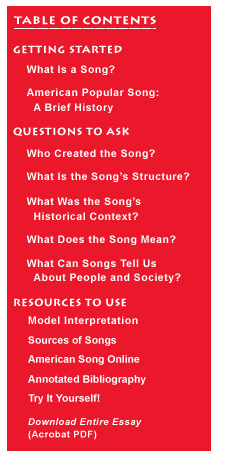talking history | syllabi | students | teachers | puzzle | about us

|
 |
| Songs of the past and the contexts of past songs are preserved in the present through historical sources. Anything that transmits a song, a rendition of the song, or the context of the song to future generations might be considered a source for that song. Historians often distinguish between primary and secondary sources. Primary sources are sources that were created at the same time or in close connection to the subject of historical research. Secondary sources are later commentaries on the subject. It is important to recognize, however, that something may be a secondary source in one context but a primary source in another, depending on the questions being asked. For example Alec Wilder’s book American Popular Song (1972) is a secondary source for songs by Jerome Kern and George Gershwin, but a primary source for songs by Alec Wilder. In general, sources for American song can be divided into five broad categories, according to the form in which they are preserved in libraries and archives. Each category can transmit both songs themselves and information about the context of songs. Manuscript materials. Manuscripts are materials written by hand or, more broadly, materials, like typescripts or computer files, that are directly produced by the person or persons being studied. Many autograph copies of songs by their lyricists and composers are extant, like Dan Emmett’s or Stephen Foster’s notebooks, or twentieth-century composers like Aaron Copland, Irving Berlin, and Cole Porter. Manuscripts include letters, diaries, and travelers’ accounts that comment on songs and performances. Also relevant are papers from show business people and businesses connected with musical performances such as theaters and booking agencies, like the famous Keith-Albee vaudeville circuit in the late nineteenth and early twentieth centuries. Libraries, archives, and museums usually keep manuscripts in separate collections. Music manuscripts may be in yet another collection. Some manuscripts are eventually published: two important examples are the nineteenth-century diaries of George Templeton Strong and Philip Hone, New Yorkers who commented on the city’s musical life. Manuscripts are also beginning to appear on the Internet as facsimiles, for instance those of the composer, Aaron Copland. Printed materials. This is probably the largest single category of potential sources, especially for the period after 1800, when various innovations in printing technology led to a rapid expansion of the kinds and quantity of materials published relating to music. Broadsides, songsters, sheet music, and anthologies of songs are among the most accessible and valuable sources for lyrics, tunes, and arrangements of songs. Among the many different kinds of printed materials available to tell us about songs and their performance are books by musicians, critics, and scholars; newspapers; fan magazines (now including online ones); show business publications like Billboard and Variety; plays; biographies; memoirs; and concert programs. Recordings. In the late nineteenth century Americans and Europeans began to invent various ways of reproducing musical performances mechanically, first through wax recording cylinders and paper rolls for player pianos, then through ever more sophisticated formats–records, movies, long-playing records, audio tape, CDs, and DVDs. These technologies make research easier by enabling us to hear, and even to see, actual performances. They must, however, be used with the same caution reserved for all kinds of evidence–who made the recording? for what purpose? what and who might not have been recorded? did the technology shape or limit the performance (as in early recordings, which could only play about three minutes of music and did not reproduce its full sonic spectrum)? Visual materials. These include sources already mentioned–most notably movies, television shows, and DVDs–but also such things as photographs of performers and performances, the latter of which can tell us much about performance styles and about audiences. The covers of sheet music and record and CD jackets contain useful information about songs, as well as about how performers and publishers wanted to represent themselves and their music to the public. Oral history. A growing list of oral history projects documents the lives and work of twentieth-century musicians. When available, oral histories are extremely valuable when handled with care. Like all human beings, musicians misremember things, tell stories that aren’t true, and see things from their own particular perspectives. Use oral histories to gain insights unavailable through other sources and find clues to other sources that might otherwise not be apparent. (For a guide to analyzing oral history, please see “Making Sense of Oral History.”)
Documenting Sources When working with music, document songs and renditions of songs as fully and carefully as possible. For a piece of printed music the basic documentation includes title, composer, lyricist, date of composition, publisher, date of publication, and place of publication. For a commercial recording it includes the above plus names of the performers, the recording company, catalog number, date of recording, and date the recording was issued. For a video or film it includes similar information about the item and the people who produced and performed in it. The most important thing is to identify the song or the rendition unequivocally, so others can locate it if they wish. Good documentation also enables you to know which songs or renditions are the same, which are different, and to compare them. You can trace, for example, how Elvis Presley’s music changed when he moved from a small independent company, Sun Records, to RCA, a major commercial label, and as he worked with different musicians, producers, and songwriters. Often it is impossible to obtain all of the basic documentation for a song, but every little bit helps to locate it in its proper context and to tell one item from another. |
|

|
|
